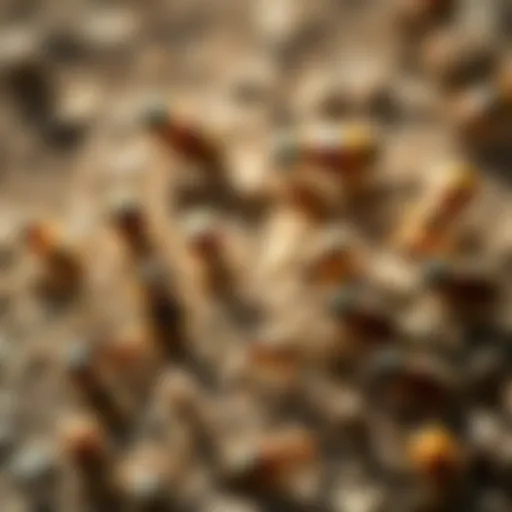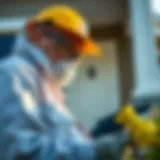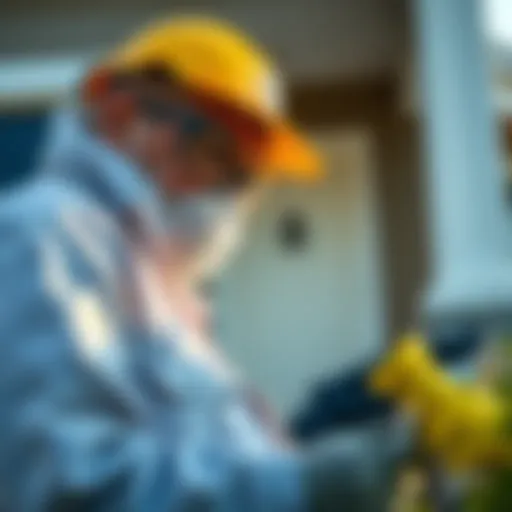Understanding the Attic Tent: Practical Applications
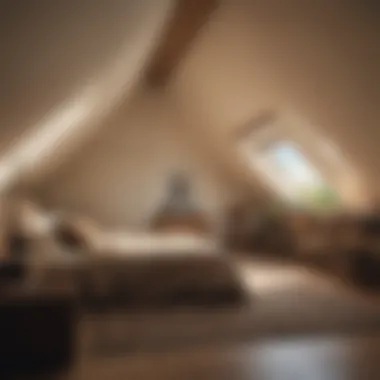

Intro
The desire for a comfortable home is a universal truth among homeowners. However, the challenges posed by pests and energy inefficiency can complicate that pursuit. Among the innovative solutions available, the attic tent stands out. It serves as a dual-purpose tool that enhances energy efficiency while also aiding in pest management. By creating a barrier between the living space and the attic, it helps keep the climate controlled and discourages unwanted pests.
In this article, we will explore various aspects of attic tents, including their functionality, benefits, and installation. Additionally, we will delve into practical considerations that every homeowner should keep in mind when integrating this product into their home.
Understanding the nuances of pest identification is crucial for homeowners. Therefore, we begin there.
Prologue to Attic Tents
Attic tents have emerged as a notable solution for improving both insulation and pest control within residential structures. Understanding the functionality and practical applications of attic tents is crucial for homeowners looking to optimize their living spaces. However, the significance of attic tents goes beyond mere insulation; they play a critical role in maintaining energy efficiency, which is often underestimated.
A thorough grasp of what attic tents are and how they operate can help homeowners make informed decisions regarding their installation. These structures create a barrier between the living areas of a home and the often harsh conditions present in the attic. By reducing the transfer of heat during winter or cooling costs in the summer, attic tents can lead to significant energy savings.
Definition of an Attic Tent
An attic tent is a specialized cover designed to seal off the attic hatch, minimizing airflow between the attic and the living areas. It typically comprises an insulating material that enhances thermal resistance while providing a barrier against pests. The design ensures a snug fit around the access point, which is critical for combating air leaks.
Purpose and Importance
The primary purpose of an attic tent is to improve home insulation and reduce energy consumption. When properly installed, these tents contribute to a stable indoor climate regardless of external weather conditions. They effectively limit the transfer of heat, making it easier to maintain comfort without excessive reliance on heating or cooling systems. Furthermore, attic tents help guard against pest infestations, thus contributing to a healthier living environment. This dual functionality highlights their importance in both energy efficiency and household maintenance.
Insulation Benefits
The insulation benefits of attic tents are critical to enhancing the overall comfort and energy efficiency of a home. This section delves into two key areas: temperature regulation and energy efficiency. Both aspects highlight how attic tents can influence climate control within a household, making them a valuable investment for homeowners seeking to improve their living environment.
Temperature Regulation
Effective temperature regulation is vital for maintaining a comfortable indoor atmosphere, regardless of the seasons. Attic tents serve as significant barriers to unwanted heat transfer, especially in regions experiencing extreme temperatures. During winter, these tents help keep the warmth generated by heating systems from escaping into the attic, which is often a major source of heat loss. Conversely, in summertime, attic tents can prevent excess heat from entering living spaces, thereby contributing to a cooler indoor climate.
Maintaining a balanced temperature in a home leads to several positive outcomes:
- Enhanced Comfort: Homeowners can enjoy a more consistent temperature throughout the house, reducing cold drafts and hot spots.
- Health Benefits: Stable indoor temperatures contribute to a healthier living environment, minimizing the potential for mold growth which thrives in fluctuating temperatures.
Energy Efficiency
Energy efficiency is a significant concern for many homeowners, affecting both environmental impact and monthly utility costs. Attic tents contribute to energy efficiency by minimizing the demand on heating and cooling systems. By reducing the need for constant climate control adjustments, these tents reduce energy waste, leading to lower electricity and gas bills.
Investing in an attic tent can yield several financial advantages:
- Cost Savings: Homeowners can expect decreased energy bills following the installation of an attic tent, as efficiency improves.
- Return on Investment: Many energy efficiency upgrades, including attic tents, qualify for tax credits or rebates, further enhancing their financial appeal.
Pest Prevention Strategies
Pest prevention is a critical aspect of maintaining a healthy and functional home. In the context of attic tents, these strategies assume greater significance due to the unique challenges posed by pests in the attic environment. Implementing effective pest prevention measures not only protects the integrity of the home but also enhances the overall effectiveness of insulation efforts. Here, we examine the role of attic tents in pest management, and how they can be utilized to create a barrier against unwanted intruders.
Barrier Protection
Barrier protection is one of the primary functions of an attic tent. By creating a sealed barrier between the attic space and the rest of the house, an attic tent effectively reduces the chances of pests infiltrating the living areas below. This barrier is particularly important because attics can serve as prime breeding grounds for various animals and insects due to their warm and usually dark environment.
The materials used in constructing attic tents play a vital role in their efficacy. High-quality fabrics that are resistant to tears and punctures are essential. This ensures that rodents or insects cannot easily breach the tent. Additionally, a properly sealed attic tent minimizes gaps that serve as entry points for pests.
Ultimately, a well-installed attic tent not only contributes to insulation but also acts as an effective barrier against potential pest infestations. This dual purpose makes it a valuable addition to any home.
Common Pests Affected
Attic tents can be particularly effective in addressing some common pest issues. The following pests frequently invade attics:
- Rodents: Mice and rats can find their way into attics through small openings. They can cause significant damage to insulation and wiring, and may even carry diseases.
- Bats: These flying mammals tend to roost in attics. They can create messes with their droppings, which could lead to health risks.
- Squirrels: These creatures can enter attics by creating openings in soffits and eaves. Once inside, they can chew wires and insulation.
- Insects: This includes spiders, ants, and termites, which can cause varying degrees of structural damage.
By utilizing a tent specifically designed to block off the attic from the outside, homeowners can significantly reduce the likelihood of these pests establishing a presence in their homes. Effective pest prevention not only protects the physical structure but contributes to the overall safety and cleanliness of living areas.
Installation Process
The installation process of an attic tent is crucial. It determines how effectively the tent will function in insulating your home. Proper installation ensures that the tent creates an airtight seal. This is essential for regulating temperature and preventing pests. Understanding the installation steps will help you maximize the benefits of using an attic tent.
Necessary Tools and Materials
Before starting the installation, gather the right tools and materials. Below is a list of what's required:
- Attic tent: Ensure it's the proper size for your attic opening.
- Measuring tape: Accurate measurements are vital for a snug fit.
- Utility knife: This will help to cut the material if needed.
- Staple gun: To secure the attic tent in place.
- Safety goggles: Protect your eyes during installation.
- Knee pads: They can offer comfort when working in confined spaces.
Having these materials prepared will streamline the installation process.
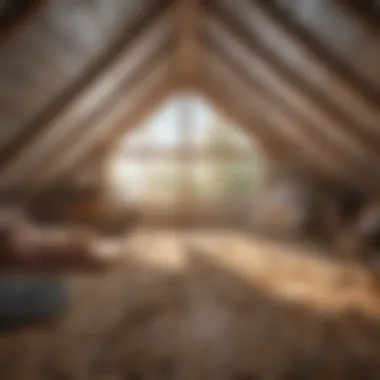

Step-by-Step Installation Guide
Installing an attic tent can be done with careful attention to detail. Follow this step-by-step guide for best results:
- Measure the Opening: First, use a measuring tape to determine the size of your attic opening. This will ensure that the tent fits properly.
- Prepare the Area: Clear any debris or obstruction from the attic space. Ensure it is safe to work in.
- Position the Tent: Take the attic tent and place it over the opening. Verify that it aligns correctly with the edges.
- Cut if Necessary: If the tent is too large, use the utility knife to trim it down to the right size.
- Secure with Staple Gun: Use the staple gun to attach the attic tent to the surrounding structure. Make sure it is tight against the surface to prevent air leaks.
- Seal the Edges: Check for gaps around the edges. Use additional materials like weather stripping or duct tape to seal any openings.
- Final Inspection: Stand back and inspect the installation. Ensure everything is secure and the tent fits well.
Proper installation is vital for maximizing efficiency and preventing common issues.
Following these steps will help ensure that your attic tent performs well. A well-installed attic tent can contribute significantly to energy efficiency and pest prevention.
Considerations Before Installation
Before installing an attic tent, it is crucial to think through several considerations that could affect its effectiveness and overall benefits. Proper planning can mean the difference between a successful installation experience and unforeseen issues down the line. This section will delve into two key elements: assessing the attic space and material quality.
Assessing Attic Space
Assessing the attic space is one of the first steps in the installation process. Not all attics are created equal. Factors such as the size, shape, insulation levels, and existing conditions of the attic influence how and where the attic tent should be placed.
- Space Dimensions: Homeowners should measure the length, width, and height of their attic. This will help them choose the right size tent. Manufacturers often provide guidelines on size compatibility based on space dimensions.
- Accessibility: Ensure that the attic is accessible for installation and future maintenance. If an area is difficult to reach, it could become a hassle later to check for wear or tear.
- Current Insulation: Homeowners need to note the existing insulation levels. If the attic lacks proper insulation, additional measures may be necessary before or after the installation of the attic tent.
"A well-prepared attic space enhances the performance of an attic tent, leading to better insulation and pest prevention outcomes."
Material Quality
The quality of materials used in an attic tent directly impacts its durability and effectiveness. Homeowners should prioritize high-quality products for lasting performance. Here are some considerations for material quality:
- Thermal Resistance: Check the R-value of the materials. A higher R-value indicates better insulation performance, which is essential for energy efficiency.
- Pest Resistance: Ensure the materials are resistant to pests. Some materials may be more prone to damage or infestation.
- Environmental Impact: Consider products made from sustainable materials. These options not only reduce a carbon footprint but can also contribute to healthier living environments.
When selecting a product, it can be beneficial to consult with experts or refer to reputable sources for guidance. Quality materials will ensure the attic tent serves its purpose effectively, minimizing energy loss and deterring pest issues.
Maintenance of Attic Tents
Maintaining an attic tent is crucial for ensuring its longevity and effectiveness. Regular upkeep prevents problems that can arise from neglect, such as insulation loss or pest infestations. Effective maintenance contributes to the overall energy efficiency of a home and protects the investment made in the attic tent product. Homeowners should be mindful not only of physical damage but also of how environmental factors affect their attic space.
Regular Inspections
Regular inspections of the attic tent should be a priority for homeowners. It is advisable to schedule these inspections every six months or at least once a year. During these inspections, look for any signs of wear, such as tears in the material or weakening seams. Special attention should be paid to the attachment points and seals where the tent fits against the attic access point.
Inspecting for mold or moisture buildup is also essential. Excessive humidity can damage the insulation properties and create a breeding ground for pests. By conducting thorough inspections, homeowners can identify issues before they turn into costly repairs or significant energy loss.
Common things to check during an inspection include:
- Material integrity. Look for holes or rips.
- Seal quality. Ensure all edges are well-sealed against airflow.
- Pest entry points. Check for any insects or rodents that may have found a way through.
Maintaining active vigilance through regular inspections helps keep the attic tent functioning optimally, safeguarding against potential failures.
Cleaning and Care Tips
Cleaning the attic tent is a vital aspect of maintenance that often goes overlooked. Dust accumulation and cobwebs can affect not just the tent but the overall attic environment. Here are some simple cleaning tips:
- Vacuum Regularly: Use a soft brush attachment to gently remove dust and debris from the surface of the tent. This prevents buildup and maintains the aesthetics and function of the product.
- Wipe Down Surfaces: For any stains or spots, lightly dampen a cloth with water and wipe. Avoid harsh chemicals, as they may degrade the materials or coatings used in the tent.
- Check for Contaminants: Pay attention to any signs of water damage or the presence of mold. If mildew or moisture is detected, attempt to dry the area thoroughly. Consult professionals if needed to handle a serious mold infestation.
- Inspect and Maintain: After cleaning, it's a good time to carry out an inspection to ensure the tent remains in good condition.
By integrating these cleaning and care tips into routine household tasks, homeowners will enhance the performance and lifespan of their attic tent.
"A well-maintained attic tent is an investment in energy efficiency and pest prevention, pivotal to maintaining a comfortable home environment."
Cost vs. Value Analysis
When homeowners consider making any improvements to their property, it is vital to evaluate the cost versus the value of those renovations. This applies strongly to the addition of an attic tent. The significance of this analysis lies in the financial commitment required to install the tent and the potential for long-term benefits.
Investing in an attic tent not only enhances energy efficiency but also contributes to pest management. Understanding how much installation might cost versus the savings accrued over time is essential. Homeowners can feel more confident about their decision when they conduct a thorough assessment of the financial implications.
Initial Investment Considerations
Prior to installing an attic tent, homeowners should examine the initial costs involved. This includes not just the price of the attic tent itself, but also any additional materials, tools, and labor that might be necessary.
- Product Pricing: The cost of an attic tent can vary significantly based on brands like Energy Star or Attic Tent. Homeowners should research multiple options to find the best fit for their budget.
- Installation Expenses: There are two main choices: do-it-yourself installation or hiring contractors. DIY may save money, but could lead to mistakes, while professional installation incurs labor costs.
- Quality of Materials: Higher-quality materials may cost more initially but offer better performance and longevity.
Taking these considerations into account allows homeowners to make an informed choice.
Long-Term Savings Projection
Long-term savings are a crucial component to weigh against the initial investment. An attic tent can significantly reduce energy costs, especially in homes with central heating and cooling systems.
- Energy Bills Reduction: By controlling the temperature in the attic, an attic tent minimizes the workload on HVAC systems. This often results in lower monthly utility bills.
- Durability and Longevity: A quality attic tent can last over a decade. The extended lifespan ensures that homeowners will continue to reap savings year after year.
- Expanded Property Value: As energy efficiency becomes a priority in the housing market, homeowners can see an increase in property value. Energy-efficient homes are often more attractive to buyers.


Homeowners can expect to see a return on investment when they integrate energy-saving solutions like attic tents. Much of the financial gain comes from reduced energy usage over time.
Calculating projected savings can be somewhat complex, but the effort pays off. Homeowners must factor in their local energy consumption, usage patterns, and costs. By comparing these elements to the upfront costs, a clearer picture of the financial benefits emerges.
Environmental Impact
Understanding the environmental impact of attic tents is crucial in today's world, where homeowners are increasingly focused on sustainability. This section discusses the positive effects that attic tents have on the environment and the considerations homeowners need to be aware of.
Sustainable Materials
A significant aspect of attic tents is the emphasis on sustainable materials used in their construction. Many manufacturers are now opting for eco-friendly options. This includes materials like recycled textiles or natural fibers that minimize the ecological footprint. Homeowners should look for attic tents that use non-toxic adhesives and zero-VOC sealants. Not only do these materials benefit the environment, but they also ensure a healthier living space.
When considering attic tents, it is advisable to explore the brands committed to sustainability. Consumers can make informed choices by researching companies’ practices and certifications. This contributes not only to effective insulation and pest management but also promotes a greener planet.
Energy Conservation Importance
Attic tents play an important role in energy conservation. Insulating the attic effectively reduces the energy load required to heat or cool a home. Less energy consumption translates to lower utility bills and a decrease in greenhouse gas emissions. This makes attic tents a viable solution for homeowners aiming to reduce their carbon footprint.
Furthermore, by improving energy efficiency, attic tents decrease reliance on heating and cooling systems. This results in longer-lasting equipment and reduced maintenance costs. Homeowners should view this as an investment, not just in their property but also for future generations.
In summary, the environmental impact of attic tents cannot be overstated. By using sustainable materials and contributing to energy conservation, attic tents serve as a practical choice. They not only enhance a home’s comfort but also align with broader ecological goals, providing a path toward a more sustainable future.
Comparison with Other Insulation Methods
The topic of comparing attic tents with other insulation methods is essential to understand the unique benefits and limitations of attic tents. For homeowners, choosing the right insulation approach can significantly impact energy efficiency, comfort, and even pest management. This section explores various traditional insulation solutions, their characteristics, and how they stack up against attic tents.
Traditional Insulation Solutions
Traditional insulation options include fiberglass batts, spray foam, and cellulose. Each of these materials has its unique attributes:
- Fiberglass Batts: These are pre-cut panels made of glass fibers. They are relatively affordable and easy to install. However, they require a proper fitting to avoid gaps which can reduce their effectiveness in insulating a home.
- Spray Foam: This insulation expands upon application, filling cracks and gaps effectively. It provides a superior air seal and high insulation value. While very effective, it tends to be more expensive and often requires professional installation.
- Cellulose: Made from recycled paper products, cellulose is treated for fire resistance. It is often used in retrofitting existing homes as it can be blown into walls and attics. It is eco-friendly but may require more frequent settling and can lose insulation value over time if it gets wet.
Each of these solutions has advantages but also some drawbacks. Knowing these offers a greater context when discussing the role of attic tents in insulation.
Benefits and Disadvantages
Benefits of Attic Tents:
- Easy Installation: Attic tents are designed to be user-friendly. Homeowners can often install them without professional help, saving on labor costs.
- Targeted Insulation: The tent creates an air barrier specifically for the attic hatch, reducing heat loss in a critical area.
- Enhanced Pest Control: Unlike many traditional insulations, attic tents can help impede pest entry, addressing two problems at once.
- Cost-Effective: Though they require an initial investment, the energy savings over time can make attic tents a frugal choice compared to some other methods.
Disadvantages of Attic Tents:
- Limited Coverage: Attic tents are not a full insulation solution. They work best in conjunction with other methods.
- Material Limitations: Their effectiveness depends a lot on the quality of materials used. Lower-quality attic tents can wear out quickly.
- Potential for Misplacement: If not installed correctly, attic tents may not provide the intended insulation benefits or pest barrier.
In summary, while attic tents present themselves as a viable option in insulation practices, they should complement other established methods. Each insulation type has its specific niche, and understanding these can guide homeowners in making informed decisions that suit their unique needs.
User Experiences and Testimonials
User experiences and testimonials play a crucial role in understanding the effectiveness and practicality of attic tents. Feedback from actual users can provide insights that academic articles or theoretical discussions may overlook. These testimonials highlight real-world applications, benefits, and challenges that come with using attic tents. Such information can be highly valuable for homeowners contemplating this installation.
Positive Outcomes
Many homeowners report significant improvements after installing attic tents. These positive outcomes often include enhanced energy efficiency, leading to a decrease in heating and cooling costs. For instance, users have noted more stable indoor temperatures throughout the year, reducing the reliance on heating and air conditioning systems. This has not only contributed to lower utility bills but also improved comfort in their homes.
- Key benefits reported include:
- Decreased energy consumption
- Improved comfort levels in upper living spaces
- Reduction in pest entry points
- Enhanced overall attic conditions
Moreover, several users experienced fewer pest-related issues post-installation. This has been particularly beneficial in regions prone to infestations from rodents or insects. The attic tent creates a barrier, thus reducing potential nesting sites while allowing for better insulation.
Challenges Faced
Despite the numerous benefits, some homeowners have shared their challenges regarding attic tents. Issues often arise during installation, particularly if the attic space is cramped or not easily accessible. In such cases, proper measurements and adjustments become critical.
- Common challenges include:
- Difficult installation due to limited space
- Incorrect sizing leading to gaps or poor fit
- Maintenance troubles if not regularly inspected
Additionally, some users have reported minor effectiveness issues if the attic is not sufficiently sealed before installation. This can negate some insulation benefits. It underscores the importance of thorough attic assessments prior to proceeding with installation, ensuring a successful outcome.
"While the attic tent significantly improved our energy efficiency, the installation process highlighted the need for proper planning. We wish we had prepared better."
— Homeowner Testimonial
Expert Opinions
Understanding the perspective of experts is crucial when examining the utility of attic tents. Their insights provide significant value in several areas, including installation methods, effectiveness, and long-term maintenance. Homeowners gain practical knowledge from specialists, which can influence their purchasing decisions and installation approaches. Experts in insulation and pest control offer careful analysis of benefits, drawbacks, and expected outcomes.


Interviews with Pest Control Specialists
Interviews with pest control specialists emphasize the pivotal role attic tents play in preventing infestations. These experts highlight that a properly installed attic tent can serve as a formidable barrier against pests such as rodents and insects. Their professional experiences confirm that sealing the attic reduces potential entry points. This increased security minimizes the risk of infestations, ensuring that homeowners maintain a healthy living environment.
Additionally, pest control specialists often stress the importance of regular inspections. Keeping the attic well-sealed and monitored will help in early detection of any pest activity. They recommend integrating pest monitoring systems with attic tents for enhanced protection.
Insulation Experts' Insights
The insights from insulation specialists shed light on the technical merits of attic tents. They articulate how effectively these materials mitigate energy loss, improve temperature regulation, and contribute to overall household energy efficiency. Insulation experts underscore the practicality of selecting high-quality materials; it often translates into significant savings on energy bills over time.
Moreover, insulation specialists frequently recommend conducting an energy audit before installation. This step allows homeowners to ascertain the specific insulation needs of their attic.
Expert input on the longevity and durability of insulation materials is equally important. Quality plays a pivotal role in how well the attic tent performs under varying climate conditions. By understanding these technical aspects, homeowners are better equipped to make informed decisions.
"Investing in an attic tent not just improves insulation; it can also transform how homeowners view their energy efficiency and pest management strategies." - Insulation Specialist
Future Trends in Attic Insulation
The landscape of attic insulation is evolving with advancements in technology and shifts in market demands. Understanding these future trends is crucial for homeowners and industry professionals. In this section, we will delve into the innovations that are shaping attic insulation and how they are influencing both functionality and efficiency.
Technological Innovations
Recent technological innovations are transforming the insulation industry. New materials are being developed that promise enhanced thermal performance. For instance, vacuum insulation panels (VIPs) are becoming more accessible. These panels offer superior insulation with reduced thickness, allowing homeowners to save space while maximizing efficiency. Additionally, smart home technology is also being integrated with insulation solutions.
- Smart sensors can track temperature variations within the attic space and provide real-time data.
- Homeowners can adjust heating and cooling settings based on this information.
This ability to monitor and optimize attic conditions leads to more effective energy management. Moreover, the ongoing research in eco-friendly materials is reshaping the industry. Bio-based insulation materials made from renewable resources can now compete in effectiveness with traditional options while also minimizing environmental impact.
Market Trends and Evolutions
The market for attic insulation is adapting to new consumer demands and preferences. There is a noticeable shift towards sustainability. Homeowners are increasingly seeking sustainable options as they become more eco-conscious.
- Natural insulation materials like sheep wool and cellulose are gaining popularity. These not only provide adequate insulation but are also biodegradable and less hazardous during installation.
This trend is being supported by government regulations encouraging energy-efficient home improvements. Many local and federal programs now offer incentives for installing innovative insulation solutions, thus encouraging more homeowners to consider upgrades.
"Sustainable insulation not only protects our environment but can also lead to significant long-term savings in energy costs."
The rise of online marketplaces is also significantly affecting how insulation products are being sold. Homeowners can compare features, read reviews, and order materials conveniently. This accessibility can empower them to make more informed choices about insulation solutions, further driving trends towards efficiency and sustainability.
Regulations and Compliance
Understanding regulations and compliance is critical when considering the installation and use of an attic tent. Proper adherence to these guidelines not only ensures safety but also promotes efficiency in insulation and pest management practices. Compliance with specified standards can enhance the overall effectiveness of the attic tent and protect the homeowner's investment.
Building Codes and Standards
Building codes and standards vary from one region to another. They are designed to ensure the safety and functionality of any construction or remodeling project, including the installation of an attic tent. Homeowners should be informed about the specific codes applicable to their area before proceeding with installation.
Some important aspects to consider include:
- Local Requirements: Homeowners must check local building codes. This may include requirements for insulation levels, ventilation, and materials used in construction.
- Permits: Some areas may require permits to install attic tents. Not following this rule can result in fines or complications during home evaluations.
- Longevity: Adhering to building codes prolongs the life of the attic tent. It helps ensure proper installation and protects against future structural issues.
Homeowners can visit en.wikipedia.org to gather more information regarding building codes in their particular regions, helping them stay compliant and informed.
Health and Safety Regulations
Health and safety regulations are equally important when discussing attic tents. These regulations help protect homeowners and their families by ensuring that construction practices do not compromise health. Some relevant regulations include:
- Material Safety: The materials used in attic tents must be free from harmful chemicals or toxins. This consideration is vital to avoid health hazards such as respiratory issues.
- Fire Safety: Cellular materials, for example, need to meet fire safety standards. Homeowners should ensure the attic tent products carry proper certifications indicating compliance with fire regulations.
- Installation Practices: Proper installation, following industry standards, can prevent hazards like poor ventilation or structural failure, making it essential for creating a safe living environment.
The significance of adhering to health and safety regulations cannot be overstated. Homeowners should prioritize safety to protect themselves and their loved ones.
In summary, homeowners should take the time to understand the regulations and compliance required for the installation of attic tents. This attention to detail not only ensures safety but also contributes to enhanced insulation and pest management effectiveness.
The End
In summarizing the information about attic tents, it is essential to recognize their multifaceted role in both insulation and pest management. The detailed exploration of these concepts highlights their practical applications and underscores their growing importance for homeowners and property managers.
Recap of Key Points
Attic tents offer several benefits, notably:
- Insulation Improvement: They effectively regulate temperature, which can reduce energy costs.
- Pest Control: Their structure prevents rodents and insects from entering attic spaces, safeguarding home environments.
- Cost Efficiency: While there is an initial investment, the long-term savings on energy bills and pest control measures make them financially advantageous.
- Ease of Installation: Instructions for installation are straightforward, making them accessible even for those with limited DIY experience.
In addition, maintaining an attic tent through regular inspections ensures its efficiency and effectiveness over time.
Final Thoughts
Integrating an attic tent into home improvement initiatives emerges as a sound choice. As property owners concentrate on maintaining energy efficiency and pest-free environments, the value of such innovations in insulation technology cannot be overstated.
With ongoing advancements in materials and designs, it is reasonable to anticipate that attic tents will play an increasingly significant role in the evolution of home maintenance strategies. Educating oneself about these benefits, combined with proper installation and maintenance practices, holds the potential to enhance overall home quality and comfort.

